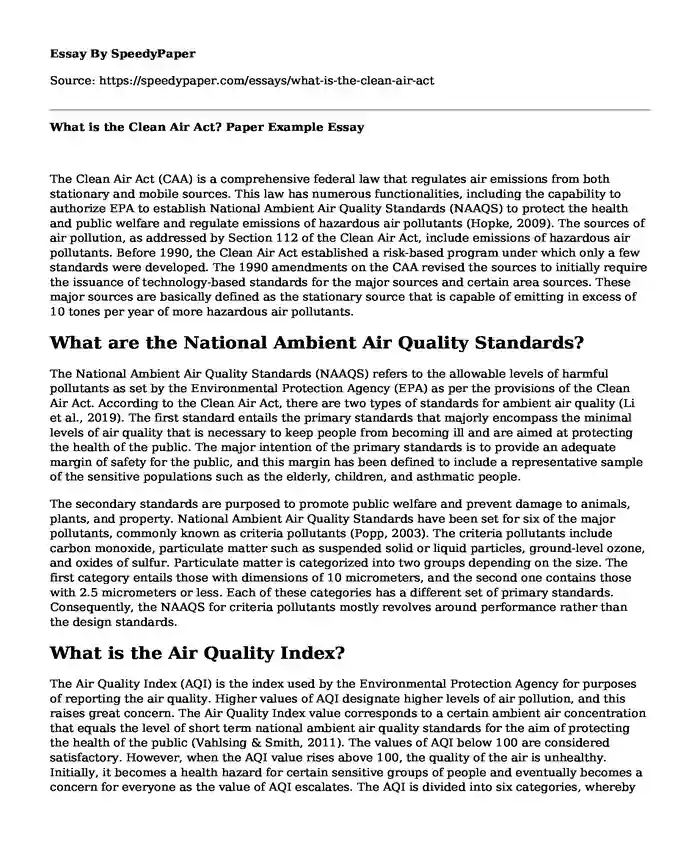
| Type of paper: | Essay |
| Categories: | Law Ecology Air pollution |
| Pages: | 3 |
| Wordcount: | 644 words |
The Clean Air Act (CAA) is a comprehensive federal law that regulates air emissions from both stationary and mobile sources. This law has numerous functionalities, including the capability to authorize EPA to establish National Ambient Air Quality Standards (NAAQS) to protect the health and public welfare and regulate emissions of hazardous air pollutants (Hopke, 2009). The sources of air pollution, as addressed by Section 112 of the Clean Air Act, include emissions of hazardous air pollutants. Before 1990, the Clean Air Act established a risk-based program under which only a few standards were developed. The 1990 amendments on the CAA revised the sources to initially require the issuance of technology-based standards for the major sources and certain area sources. These major sources are basically defined as the stationary source that is capable of emitting in excess of 10 tones per year of more hazardous air pollutants.
What are the National Ambient Air Quality Standards?
The National Ambient Air Quality Standards (NAAQS) refers to the allowable levels of harmful pollutants as set by the Environmental Protection Agency (EPA) as per the provisions of the Clean Air Act. According to the Clean Air Act, there are two types of standards for ambient air quality (Li et al., 2019). The first standard entails the primary standards that majorly encompass the minimal levels of air quality that is necessary to keep people from becoming ill and are aimed at protecting the health of the public. The major intention of the primary standards is to provide an adequate margin of safety for the public, and this margin has been defined to include a representative sample of the sensitive populations such as the elderly, children, and asthmatic people.
The secondary standards are purposed to promote public welfare and prevent damage to animals, plants, and property. National Ambient Air Quality Standards have been set for six of the major pollutants, commonly known as criteria pollutants (Popp, 2003). The criteria pollutants include carbon monoxide, particulate matter such as suspended solid or liquid particles, ground-level ozone, and oxides of sulfur. Particulate matter is categorized into two groups depending on the size. The first category entails those with dimensions of 10 micrometers, and the second one contains those with 2.5 micrometers or less. Each of these categories has a different set of primary standards. Consequently, the NAAQS for criteria pollutants mostly revolves around performance rather than the design standards.
What is the Air Quality Index?
The Air Quality Index (AQI) is the index used by the Environmental Protection Agency for purposes of reporting the air quality. Higher values of AQI designate higher levels of air pollution, and this raises great concern. The Air Quality Index value corresponds to a certain ambient air concentration that equals the level of short term national ambient air quality standards for the aim of protecting the health of the public (Vahlsing & Smith, 2011). The values of AQI below 100 are considered satisfactory. However, when the AQI value rises above 100, the quality of the air is unhealthy. Initially, it becomes a health hazard for certain sensitive groups of people and eventually becomes a concern for everyone as the value of AQI escalates. The AQI is divided into six categories, whereby each of these categories corresponds to a certain level of health concern.
References
Hopke, P. (2009). Environmental Chemometrics. Comprehensive Chemometrics, 55-74. https://doi.org/10.1016/b978-044452701-1.00008-9
Li, H., Wang, J., Li, R., & Lu, H. (2019). Novel analysis–forecast system based on multi-objective optimization for air quality index. Journal Of Cleaner Production, 208, 1365-1383. https://doi.org/10.1016/j.jclepro.2018.10.129
Popp, D. (2003). Pollution control innovations and the Clean Air Act of 1990. Journal Of Policy Analysis And Management, 22(4), 641-660. https://doi.org/10.1002/pam.10159
Vahlsing, C., & Smith, K. (2011). Global review of national ambient air quality standards for PM10 and SO2 (24 h). Air Quality, Atmosphere & Health, 5(4), 393-399. https://doi.org/10.1007/s11869-010-0131-2
Cite this page
What is the Clean Air Act? Paper Example. (2023, Nov 30). Retrieved from https://speedypaper.net/essays/what-is-the-clean-air-act
Request Removal
If you are the original author of this essay and no longer wish to have it published on the SpeedyPaper website, please click below to request its removal:
- Police Brutality Paper Sample: The History of African-American Suffering
- Adolescent Development Essay Sample
- Essay Example on Climate Change and River Patterns
- Essay Sample on the Training on Miranda Rights at the Police Training Centers
- Free Essay Sample on Marijuana and Canadian Workplace
- What Should the Government Do to Stop Environmental Pollution? Paper Sample
- Citizenship: Rights, Privileges & Defense of a Nation - Essay Sample
Popular categories




